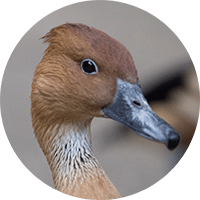Fulvous Whistling-duck
Appearance: The Fulvous Whistling-duck breeds across the world's tropical regions in much of this continent. It is a long-legged duck, mainly golden-brown with a darker back and an obvious blackish line down the back of its neck. It has whitish stripes on its flanks, a long grey bill and grey legs. In flight, the wings are brown above and black below, with no white markings, and a white crescent on the rump contrasts with the black tail. All plumages are fairly similar, but the female is slightly smaller and duller-plumaged than the male. It weighs 620 to 755 g. The juvenile has paler underparts, and appears generally duller, especially on the flanks. It has plumage that is mainly reddish brown, long legs and a long grey bill, and shows a distinctive white band across its black tail in flight.
Habitat: This duck is noisy and found in lowland marshes and swamps in open, flat country, and it avoids wooded areas and does not perch on trees. It walks well, without waddling, and normally feeds by upending, though it can dive if necessary. Single, in pairs or in small groups. Forages day or night.
Breeding: The clutch is around 6-16 whitish eggs but other females may lay into the nest, so 20 or more may be found. Eggs of other species may be added to the nest. The breeding adults, which pair for life, take turns to incubate, and the eggs hatch in 24–28 days. The ducklings leave the nest within a day or so of hatching, but the parents continue to protect them until they fledge around 9 weeks later.
Conservation: In severe decline due to pesticides and habit of nesting in rice fields.
Distribution
The Fulvous Whistling Duck is a species of waterfowl with a distinctively colored plumage. It is native to several regions around the world. Found in northern Colombia up to La Guajira. It is a fairly common and seen in less quantify.
Taxonomy
- Kingdom: Animalia
- Phylum: Chordata
- Class: Aves - Birds
- Order: Anseriformes
- Family: Anatidae
- Genus: Dendrocygna
- Species: Dendrocygna bicolor
Vocalization
The primary vocalization of the Fulvous Whistling-duck is a series of high-pitched whistling calls, which give it its common name. These whistles are often described as clear and melodious, with a rising and falling tone. The call is typically rendered as "wee-wee-wee" or "woo-woo-woo," and can be quite loud, carrying over long distances.
These vocalizations serve various purposes within the social dynamics of the fulvous whistling duck population. They are used to maintain contact between individuals, especially when they are flying in groups or moving between feeding and roosting sites. The calls help to coordinate the movements of the flock and keep individuals together.
During courtship and pair bonding, the male and female fulvous whistling ducks engage in complex vocal exchanges. The male may produce loud, repeated whistling calls while bobbing his head, which is believed to be part of a courtship display. The female responds with soft quacks or lower-pitched calls.
The fulvous whistling duck also produces various other vocalizations, including growls, grunts, and hisses. These vocalizations are often used as threat displays or warning signals to communicate aggression or territoriality.







